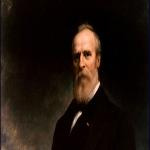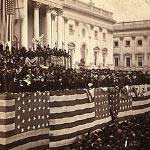
BARBARA KLEIN: Welcome to THE MAKING OF A NATION -- American history in VOA Special English.
Rutherford Hayes was sworn into office as the 19th president of the United States in 1877. Hayes, a Republican, became president after a disputed election.
Representatives of his party and the Democrats met secretly to work out a compromise.
The Democrats agreed to let Hayes be sworn in. In return, he agreed to end federal support of radical Republican governments in the South.
He promised to name southerners to his cabinet and other important jobs. And he said he would provide more federal aid for schools and railroads in the South.
As part of the agreement, Hayes promised not to act aggressively to support the civil rights of black southerners.
This week in our series, Steve Ember and Richard Rael tell the story of Rutherford Hayes.
STEVE EMBER: Rutherford Hayes was born in Ohio in 1822. He was a good student at Kenyon College and at Harvard Law School. He opened a law office in Cincinnati. When he was 30 years old, he married Lucy Webb. Later, he served as an officer in the Union army during America's Civil War. He was elected to the United States House of Representatives. He also served as governor of Ohio. In this job, he helped establish the college that became Ohio State University.
RICHARD RAEL: Hayes was a Republican. In 1876, he was the party's compromise candidate for president. His opponent in the national election was Democrat Samuel Tilden. Tilden won more popular votes than Hayes. In the American political system, whoever wins the most popular votes in a state usually gets all the electoral votes of that state.
In 1876, both the Republicans and Democrats claimed the electoral votes of three southern states: Florida, Louisiana, and South Carolina. So it was not clear at first who had won the presidential election.
STEVE EMBER: Congress appointed a committee to decide the issue. The committee had a Republican majority. It gave the disputed electoral votes to Hayes. He won the election by just one electoral vote. The results came just a few days before the inauguration.

Democrats protested that the Republicans had stolen the election. Yet they agreed to accept Hayes as president. In exchange, Hayes and the Republicans agreed to accept Democratic Party policies on several issues. Hayes's administration would deal mainly with national -- not international -- problems.
RICHARD RAEL: At first, people wondered: would President Hayes keep the promises that were made to help him win the election. Most thought he would not. Hayes surprised everyone. In his inaugural speech, he promised to put the country ahead of the party. He said, "He serves his party best who serves his country best."
Party leaders told Hayes which men to appoint to his cabinet. He refused and made his own choices. He ordered federal troops to withdraw from South Carolina and Louisiana. The troops had been there since the end of the Civil War. He also helped southern Democrats establish new governments in their states.
STEVE EMBER: Republican Party leaders criticized President Hayes. Anti-slavery groups also criticized him. They said former black slaves in the south had gained a lot under Republican rule. Now, they said, these black Americans would lose everything.
Hayes did not agree. He had received promises that the new democratic state governments would protect the rights of black Americans. It was not to be. White Democrats kept political control in some southern states for many years. They often denied civil rights to black citizens. Only with the rise of the civil rights movement in the 1950s would the situation begin to change.
RICHARD RAEL: After becoming president, Rutherford Hayes announced that he would serve just one term. He wanted to make serious reforms in the federal government. This would be easier to do if he did not have to worry about getting re-elected. Hayes started by changing the system that employed people in government jobs.
Party leaders usually had great power to fill government jobs. They used the jobs to reward loyal party workers and to increase their own political strength. President Hayes demanded that federal jobs be given to people because of their abilities, not because they supported a politician.
STEVE EMBER: At that time, the best jobs were with the customs service of the Treasury Department. The people who collected customs -- taxes on imports -- could keep part of the money they collected.
President Hayes took action against the customs service office in New York City. One of the men removed from the job there was James Garfield. Garfield would later become president of the United States.
Hayes also banned all federal workers from taking part in political organizations, conventions, and campaigns. And he said politicians no longer could demand campaign money from federal workers.
RICHARD RAEL: Rutherford Hayes showed more political strength during a nationwide railroad strike. The strike began during his first summer as president.
For several years, the nation had suffered from a serious economic depression. Three million people were out of work. Factories and businesses reduced the pay of those who still had jobs. Workers with the Baltimore and Ohio railroad protested. They took control of many areas along the railroad. They refused to let the trains move. The strike spread to other railroads. In some places, the strikes turned into riots, and the riots became violent.
Some governors ordered their state armed forces to intervene. The state forces were not strong enough, however. So the governors asked President Hayes for help. He immediately sent federal troops to troubled cities. The troops stopped the riots and ended the strikes.
STEVE EMBER: Another issue during Hayes's administration involved a railroad in the western United States. It was both a labor problem and an immigration problem. Thousands of Chinese workers had been brought to America to help build the Central Pacific Railroad. After the railroad was built, many of them remained. Most settled in California. Others came from China to join them. These immigrants competed with white workers for jobs. Whites protested, because the Chinese agreed to work for less money. They said this kept wages down for all workers.
RICHARD RAEL: The white workers asked Congress for a law to stop Chinese workers from coming to the United States. Members of Congress from both parties wanted the support of these voters. So they quickly passed a bill that made it much more difficult for Chinese citizens to come to live in the United States.
The bill said the president must cancel part of a treaty between the United States and China. That part of the treaty permitted citizens of each country to settle in the other country.
STEVE EMBER: President Hayes vetoed the bill. He said the United States had proposed the treaty. So, he said, the United States could not change it without agreement from China. Hayes did agree, however, that some action was necessary. So he opened negotiations with the Chinese government. He won an agreement to limit the number of Chinese who could enter the United States.
RICHARD RAEL: During the administrations of Andrew Johnson and Ulysses Grant, Congress had weakened many powers of the president. Congress had become the strongest of the three branches of the American government. Throughout his administration, Rutherford Hayes worked hard to strengthen presidential powers.
For example, the United States Constitution gives the president power to veto bills passed by Congress. In the 1800s, Congress tried to prevent presidential vetoes. It used a method of attaching "riders" to legislative proposals. This is how the method works:
STEVE EMBER: Congress considers a bill the president believes is necessary. Then it joins that bill to a measure the president would veto if passed separately. The extra measure is called a "rider" to the first bill. To get the bill he wants, the president must accept the "rider," too.
President Hayes refused to sign any bills with riders. So the Congress during his administration stopped using the method. Congresses since then have used it successfully.
RICHARD RAEL: Rutherford Hayes kept his promise to serve only four years. He did not regret his decision. After leaving office in 1881, he said he was satisfied with what he had done. He looked back on his administration and wrote:
"I left this great country prosperous and happy. I left the party of my choice strong, victorious, and united. In serving the country, I served my party. "He died in 1893.
STEVE EMBER: Hayes was right in saying that the United States was strong and prosperous. The late 1800s were a time of growth for the nation. They also were a time of expansion into new territory.
That will be our story next week.
(MUSIC)
BARBARA KLEIN: Our program was written by David Jarmul. The narrators were Steve Ember and Richard Rael. Our programs can be found online with transcripts, MP3s, podcasts and historical images at voaspecialenglish.com. You can also follow us on Twitter at VOA Learning English. Join us again next week for THE MAKING OF A NATION -- an American history series in VOA Special English.
Hayes wins hotly disputed 1876 election
Grant’s second term worse than first
American history series: Grant's political battles
American history series: the election of 1868
American history series: rebuilding the South
American history series: Trial of Andrew Johnson
Andrew Johnson faces a fight over aiding South
American history series: the final surrender
American history series: after Lincoln's murder
President Lincoln is shot at Ford's Theater
American history series: Robert E. Lee's surrender
American history series: Confederate capital falls
Lincoln defeats McClellan in 1864 election
Sherman burns Atlanta in March to the Sea
American history series: the battle of cold harbor
Victory at Vicksburg splits the Confederacy
American history series: Lincoln at Gettysburg
South sees protests in North as an opening
American history series: Lee and his army cross into the North
The South wins a battle, but loses Stonewall Jackson
American history series: at Bull Run, a terrible defeat for the North
American history series: South defends its capital
American history series: the Civil War at sea
Lincoln names a general to defend Washington
American history series: the North loses the first major battle of the war
American history series: the Civil War's first days
(來源:VOA 編輯:陳丹妮)
